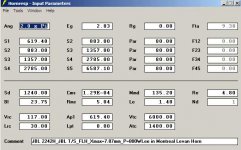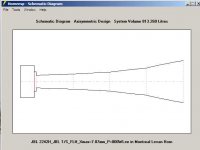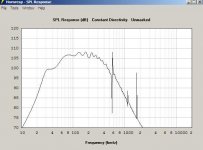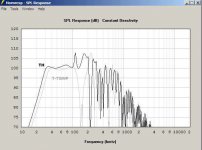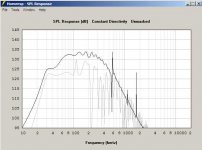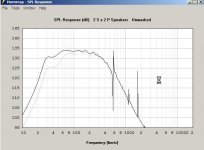Hi Lee in Montreal,
Here is a rough stab at your horn (using your numbers). V_net is 813.6 Litres, that's one big box. One of bjorno's TQWPs would be 309.1 L, and a TH 569.8 L. All of those 2pi/2.83V.
Regards,
Here is a rough stab at your horn (using your numbers). V_net is 813.6 Litres, that's one big box. One of bjorno's TQWPs would be 309.1 L, and a TH 569.8 L. All of those 2pi/2.83V.
Regards,
Attachments
Oliver,Here is a rough stab at your horn (using your numbers). V_net is 813.6 Litres, that's one big box. One of bjorno's TQWPs would be 309.1 L, and a TH 569.8 L. All of those 2pi/2.83V.
Big box is great at 60 -300 Hz ;^).
Are all three using the same driver?
What do they look like at Xmax?
Hi Lee in Montreal,
Here is a rough stab at your horn (using your numbers). V_net is 813.6 Litres, that's one big box. One of bjorno's TQWPs would be 309.1 L, and a TH 569.8 L. All of those 2pi/2.83V.
Regards,
Well, this certainly gives insight as to why these are regarded as legendary subs for club use in a solidly built rooms, think of the box at MoS. Looks like when used in groups they should have pretty flat in-room response with tons of sensitivity.
Post #22
Hi Art,
All with the JBL 2242H, and close to factory T/S (recalculated somewhat using Hornresp).
I'll attach the Hornresp Export files (for what it's worth), that way you can do some fine tuning, and get the low cutoffs similar, etc. None of this is optimized.
Regards,
Hi Art,
All with the JBL 2242H, and close to factory T/S (recalculated somewhat using Hornresp).
I'll attach the Hornresp Export files (for what it's worth), that way you can do some fine tuning, and get the low cutoffs similar, etc. None of this is optimized.
Regards,
Attachments
Thanks, Oliver.Hi Art,
All with the JBL 2242H, and close to factory T/S (recalculated somewhat using Hornresp).
I'll attach the Hornresp Export files (for what it's worth), that way you can do some fine tuning, and get the low cutoffs similar, etc. None of this is optimized.
Box is too big for my taste, and the low Xmax driver limits output by about 6 dB.
Thanks, Oliver.
Box is too big for my taste, and the low Xmax driver limits output by about 6 dB.
First, I wish to thank everyone who added their grain of salt and contributed with technical specs and infos.
Second, I also apologize for not having been too present in my own thread for the past 48 hours. I build racecars and design parts and this is entering full season, so I have a lot of work on my plate.
As was stated in my first post, this is NOT a sub for everyone's home theater or man cave. It is strictly clubbing material and for a permanent instal. Also, all the data I supplied is for half a Bertha (otherwise known as an Emerald, and both being legends among the club scene). The original Bertha uses TWO 18" woofers and measures 60" wide x 48" tall x 36" deep. The original Emerald is half as tall. My version is deeper and allows 3 extra feet of path.
To get full low end punch, it should be used with the Levan extension, and/or two up. The advantage of building half Berthas is that at 24" tall, they are easier to move around and they go thru any door. Not so at 48" tall ;-) Huge clubs usually will need only three full Berthas with Levan extensions to shake your guts. we're talking clubs with the capacity of 1000 dancers on the floor, with warehouse tall ceilings.
A front loaded horn such as this one as an advantage over a TH when size doesn't matter. Wider frequency range, and more articulate bass. Not just 2 octaves or single note bass bins. Also, while I am set on this driver, I am more than willing to explore what can improve the response and excursion (the 2242 has 18mm total excursion). Bigger/smaller back chamber. Bigger/smaller throat. The overall length with the Levan horns when used as single 18" woofer is 162" / 4.1m, and that extension can eve be a full 48" deep if wanted, bringing the total length to 174" / 4.41m. Which shows how that design can be modulated. The mouth dimensions with the Levan extension is 96" x 24". If the cabinet is stacked two up, the mouth then gets to 96" x 48".
Last edited:
Lee,Also, while I am set on this driver, I am more than willing to explore what can improve the response and excursion (the 2242 has 18mm total excursion). Bigger/smaller back chamber. Bigger/smaller throat.
Having designed and built many BR, TH, & FLH over the years, and having used Hornresp recently (by comparison to the first 30+years) to evaluate designs, I have found the measured response to deviate +/- 3 dB or more from predictions.
Changing throat and chamber size won't have that much of a deviation.
Sure, a higher compression ratio will increase sensitivity, but that is of little advantage when the cone buckles and tears- Hornresp won't tell you at what point that will happen.
Experience shows your throat dimensions are about right for a light cone like the 2242.
As a race car builder, you must know that the only replacement for displacement is an increase in RPM, not possible in subwoofers.
Using a driver with double the displacement (and a much heavier, stiffer cone) properly powered will guarantee a 6 dB increase in output.
With that capability available for less money, I just don't understand not using it, especially with the big investment in plywood and time you are planning.
Have fun, good luck with your build!
Art
Last edited:
Hi Art. Thanks for the constructive comments. Heavier cone may be stronger, but also usually also means reduced frequency range. Being able to play 30Hz to 200Hz can be very practical when getting the 2242. In term of driver price, I have acces to close to a hundred 2242, with moderate use at under $400 each. Buying a JBL woofer also means that in 10 years, I will be able to source original replacement cones. The higher efficiency of the 2242 over the BC (3+db) means I need half as much amp power. Everything is a compromise obviously. I did hear good thing about BC products and i am not being snobby... ;-) In regard of the BC18's specs,a hight Qts of 0.39 doesn't look too good to me in a horn. Looks better suited for bass reflex.
I find the sound of vocals coming through a ground located speaker to be odd, so don't ever cross subs much higher than 100 Hz.Hi Art. Thanks for the constructive comments. Heavier cone may be stronger, but also usually also means reduced frequency range. Being able to play 30Hz to 200Hz can be very practical when getting the 2242. In term of driver price, I have acces to close to a hundred 2242, with moderate use at under $400 each. Buying a JBL woofer also means that in 10 years, I will be able to source original replacement cones. The higher efficiency of the 2242 over the BC (3+db) means I need half as much amp power. Everything is a compromise obviously. I did hear good thing about BC products and i am not being snobby... ;-) In regard of the BC18's specs,a hight Qts of 0.39 doesn't look too good to me in a horn. Looks better suited for bass reflex.
The B&C drivers work great in BR, TH or FLH, 30-300 Hz would be achievable in a FLH. The cone strength is almost overkill for BR.
As far as efficiency, they have less power compression due to better cooling, which will easily offset the difference.
It really comes down to displacement, you will need almost two of the 2242 to match a B&CTBW100.
For that cost, you could almost afford to get a B&C21SW152, which would be in another class entirely.
Below you can see the response of a BC18SW115-4 in BR and the Keystone TH, which sims (and measures ) around 131 dB at 40 Hz within it's rated power and excursion. The Keystone is way less than half the size of your design, yet has similar output to 35 Hz of four of the Berthoids..
For a fixed installation with the potential to build huge cabinets, I'd be torn between TH and FLH. Without a lot of experimentation, I'd probably opt for Josh Ricci's Othorn, which in actual measurements blows away the big Bertha or the JBL cabinets mentioned earlier in the thread.
Art
Attachments
Last edited:
Two words in favor of the Bertha with JBL 2242 : F3 30Hz ;-) And another few : no need to get 3000w to get there ;-) Also, please let's respect the topic of this thread : JBL 2242 and modifed half Bertha. There's plenty of space on that forum to discuss other topics. TIA ;-)
Lee,Two words in favor of the Bertha with JBL 2242 : F3 30Hz ;-) And another few : no need to get 3000w to get there ;-) Also, please let's respect the topic of this thread : JBL 2242 and modifed half Bertha. There's plenty of space on that forum to discuss other topics. TIA ;-)
OK, respecting the topic of the thread, why would you favor a cabinet design and driver after seeing it sims so poorly compared to other designs?
Please. Read post #31. I'd hate to see that thread turned into my religion is better than yours. We all know how it ends.
I have no sub "religion", I simply prefer subs that are the best fit for the intended use.Please. Read post #31. I'd hate to see that thread turned into my religion is better than yours. We all know how it ends.
Care to answer my question posted in #31?
Thanks everyone for having contributed. That will be my last post on this forum. I have a very short fuse when it comes to people thrashing threads and having difficulties reading simple text. @ Art. You definitely are something. ;-(
As a race car builder, you must know that the only replacement for displacement is an increase in RPM
It's not the only replacement - in the mid-1980's, 1.5 litre displacement turbo-charged Formula One engines were developing up to 1,400 bhp in qualifying mode 🙂.
A bit like horn loading a loudspeaker...
Kind regards,
David
Originally Posted by weltersys
As a race car builder, you must know that the only replacement for displacement is an increase in RPM
Although an amazing feat, there is still no replacement for displacement.
Top fuel dragsters are getting around 8500 bhp from 8 liters, a slightly better power to displacement ratio- the 1.5 liter would need to do 1594 bhp to equal that.
And the top fuelers rev to around 8250 RPM, probably several thousand below the turbo-charged Formula One engines.
Of course the top fuel engine would not last through a Formula One race...
Art
As a race car builder, you must know that the only replacement for displacement is an increase in RPM
David,It's not the only replacement - in the mid-1980's, 1.5 litre displacement turbo-charged Formula One engines were developing up to 1,400 bhp in qualifying mode 🙂.
A bit like horn loading a loudspeaker...
Although an amazing feat, there is still no replacement for displacement.
Top fuel dragsters are getting around 8500 bhp from 8 liters, a slightly better power to displacement ratio- the 1.5 liter would need to do 1594 bhp to equal that.
And the top fuelers rev to around 8250 RPM, probably several thousand below the turbo-charged Formula One engines.
Of course the top fuel engine would not last through a Formula One race...
Art
Hi Y'all,
Here is the Hornresp for the combination of Bertha horn with Levan extension. The horn path could possibly benefit from a little more detail work, but I don't think it would make a difference in the output. This is for a single JBL 2242H @ ~ Xmax. It's definitely a manly sub.
Regards,
Here is the Hornresp for the combination of Bertha horn with Levan extension. The horn path could possibly benefit from a little more detail work, but I don't think it would make a difference in the output. This is for a single JBL 2242H @ ~ Xmax. It's definitely a manly sub.
Regards,
Attachments
-
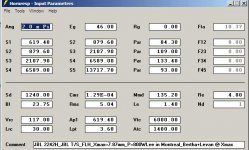 Bertha_plus_Levan_Horn_JBL_2442H_Input_Xmax.jpg37 KB · Views: 198
Bertha_plus_Levan_Horn_JBL_2442H_Input_Xmax.jpg37 KB · Views: 198 -
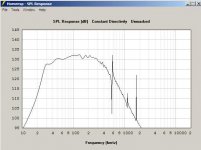 Bertha_plus_Levan_Horn_JBL_2442H_SPL_Xmax.jpg28.2 KB · Views: 210
Bertha_plus_Levan_Horn_JBL_2442H_SPL_Xmax.jpg28.2 KB · Views: 210 -
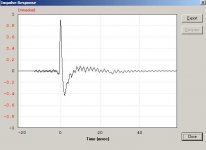 Bertha_plus_Levan_Horn_JBL_2442H_Impulse_Xmax.jpg18.5 KB · Views: 191
Bertha_plus_Levan_Horn_JBL_2442H_Impulse_Xmax.jpg18.5 KB · Views: 191 -
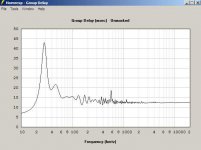 Bertha_plus_Levan_Horn_JBL_2442H_GD_Xmax.jpg27 KB · Views: 190
Bertha_plus_Levan_Horn_JBL_2442H_GD_Xmax.jpg27 KB · Views: 190 -
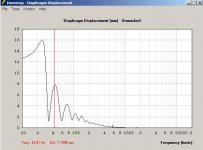 Bertha_plus_Levan_Horn_JBL_2442H_Displacement_Xmax.jpg28 KB · Views: 183
Bertha_plus_Levan_Horn_JBL_2442H_Displacement_Xmax.jpg28 KB · Views: 183
Oliver,This is for a single JBL 2242H @ ~ Xmax. It's definitely a manly sub.
Manly in size, not so manly in output. Can't win 'em all😉.
BTY, Short Fuse Lee has left the post to the ones willing to do some comparative work.
Art
- Home
- Loudspeakers
- Subwoofers
- Sub project for PA - Help needed
